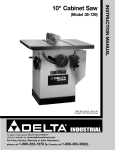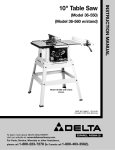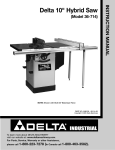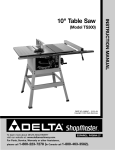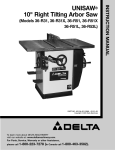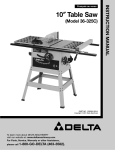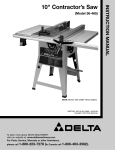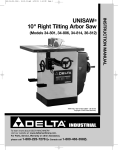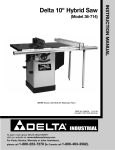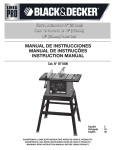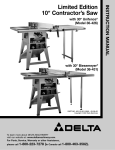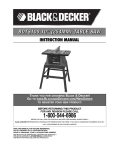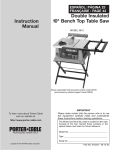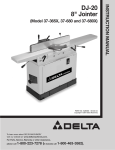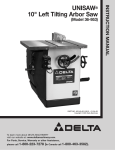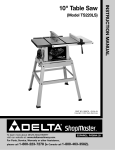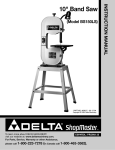Download Delta 441 Instruction manual
Transcript
(Models 36-441B, 36-451X) NOTE: Shown with UniRip® Fence System PART NO. 422-19-651-0058 - 03-22-04 Copyright © 2004 Delta Machinery To learn more about DELTA MACHINERY visit our website at: www.deltamachinery.com. For Parts, Service, Warranty or other Assistance, please call 1-800-223-7278 (In Canada call 1-800-463-3582). INSTRUCTION MANUAL 10" Contractor’s Saw SAFETY GUIDELINES - DEFINITIONS This manual contains information that is important for you to know and understand. This information relates to protecting YOUR SAFETY and PREVENTING EQUIPMENT PROBLEMS. To help you recognize this information, we use the symbols below. Please read the manual and pay attention to these sections. Indicates an imminently hazardous situation which, if not avoided, will result in death or serious injury. Indicates a potentially hazardous situation which, if not avoided, could result in death or serious injury. Indicates a potentially hazardous situation which, if not avoided, may result in minor or moderate injury. Used without the safety alert symbol indicates potentially hazardous situation which, if not avoided, may result in property damage. SOME DUST CREATED BY POWER SANDING, SAWING, GRINDING, DRILLING, AND OTHER CONSTRUCTION ACTIVITIES contains chemicals known to cause cancer, birth defects or other reproductive harm. Some examples of these chemicals are: · lead from lead-based paints, · crystalline silica from bricks and cement and other masonry products, and · arsenic and chromium from chemically-treated lumber. Your risk from these exposures varies, depending on how often you do this type of work. To reduce your exposure to these chemicals: work in a well ventilated area, and work with approved safety equipment, always wear MSHA/NIOSH approved, properly fitting face mask or respirator when using such tools. GENERAL SAFETY RULES READ AND UNDERSTAND ALL WARNINGS AND OPERATING INSTRUCTIONS BEFORE USING THIS EQUIPMENT. Failure to follow all instructions listed below, may result in electric shock, fire, and/or serious personal injury or property damage. IMPORTANT SAFETY INSTRUCTIONS Woodworking can be dangerous if safe and proper operating procedures are not followed. As with all machinery, there are certain hazards involved with the operation of the product. Using the machine with respect and caution will considerably lessen the possibility of personal injury. However, if normal safety precautions are overlooked or ignored, personal injury to the operator may result. Safety equipment such as guards, push sticks, hold-downs, featherboards, goggles, dust masks and hearing protection can reduce your potential for injury. But even the best guard won’t make up for poor judgment, carelessness or inattention. Always use common sense and exercise caution in the workshop. If a procedure feels dangerous, don’t try it. Figure out an alternative procedure that feels safer. REMEMBER: Your personal safety is your responsibility. For additional information please visit our website www.deltamachinery.com. This machine was designed for certain applications only. Delta Machinery strongly recommends that this machine not be modified and/or used for any application other than that for which it was designed. If you have any questions relative to a particular application, DO NOT use the machine until you have first contacted Delta to determine if it can or should be performed on the product. Technical Service Manager Delta Machinery 4825 Highway 45 North Jackson, TN 38305 (IN CANADA: 505 SOUTHGATE DRIVE, GUELPH, ONTARIO N1H 6M7) 2 GENERAL SAFETY RULES FAILURE TO FOLLOW THESE RULES MAY RESULT IN SERIOUS PERSONAL INJURY. 1. FOR YOUR OWN SAFETY, READ THE INSTRUCTION MANUAL BEFORE OPERATING THE MACHINE. Learning the machine’s application, limitations, and specific hazards will greatly minimize the possibility of accidents and injury. 2. WEAR EYE PROTECTION. ALWAYS USE SAFETY GLASSES. Also use face or dust mask if cutting operation is dusty. Everyday eyeglasses are NOT safety glasses. USE CERTIFIED SAFETY EQUIPMENT. Eye protection equipment should comply with ANSI Z87.1 standards, hearing equipment should comply with ANSI S3.19 standards, and dust mask protection should comply with MSHA/NIOSH certified respirator standards. Splinters, air-borne debris, and dust can cause irritation, injury, and/or illness. 3. WEAR PROPER APPAREL. Do not wear loose clothing, gloves, neckties, rings, bracelets, or other jewelry which may get caught in moving parts. Nonslip footwear is recommended. Wear protective hair covering to contain long hair. 4. DO NOT USE THE MACHINE IN A DANGEROUS ENVIRONMENT. The use of power tools in damp or wet locations or in rain can cause shock or electrocution. Keep your work area well-lit to prevent tripping or placing arms, hands, and fingers in danger. 5. MAINTAIN ALL TOOLS AND MACHINES IN PEAK CONDITION. Keep tools sharp and clean for best and safest performance. Follow instructions for lubricating and changing accessories. Poorly maintained tools and machines can further damage the tool or machine and/or cause injury. 6. CHECK FOR DAMAGED PARTS. Before using the machine, check for any damaged parts. Check for alignment of moving parts, binding of moving parts, breakage of parts, and any other conditions that may affect its operation. A guard or any other part that is damaged should be properly repaired or replaced. Damaged parts can cause further damage to the machine and/or injury. 7. KEEP THE WORK AREA CLEAN. Cluttered areas and benches invite accidents. 8. KEEP CHILDREN AND VISITORS AWAY. Your shop is a potentially dangerous environment. Children and visitors can be injured. 9. REDUCE THE RISK OF UNINTENTIONAL STARTING. Make sure that the switch is in the “OFF” position before plugging in the power cord. In the event of a power failure, move the switch to the “OFF” position. An accidental start-up can cause injury. 10. USE THE GUARDS. Check to see that all guards are in place, secured, and working correctly to prevent injury. 11. REMOVE ADJUSTING KEYS AND WRENCHES BEFORE STARTING THE MACHINE. Tools, scrap pieces, and other debris can be thrown at high speed, causing injury. 12. USE THE RIGHT MACHINE. Don’t force a machine or an attachment to do a job for which it was not designed. Damage to the machine and/or injury may result. 13. USE RECOMMENDED ACCESSORIES. The use of accessories and attachments not recommended by Delta may cause damage to the machine or injury to the user. 14. USE THE PROPER EXTENSION CORD. Make sure your extension cord is in good condition. When using an extension cord, be sure to use one heavy enough to carry the current your product will draw. An undersized cord will cause a drop in line voltage, resulting in loss of power and overheating. See the Extension Cord Chart for the correct size depending on the cord length and nameplate ampere rating. If in doubt, use the next heavier gauge. The smaller the gauge number, the heavier the cord. 15. SECURE THE WORKPIECE. Use clamps or a vise to hold the workpiece when practical. Loss of control of a workpiece can cause injury. 16. FEED THE WORKPIECE AGAINST THE DIRECTION OF THE ROTATION OF THE BLADE, CUTTER, OR ABRASIVE SURFACE. Feeding it from the other direction will cause the workpiece to be thrown out at high speed. 17. DON’T FORCE THE WORKPIECE ON THE MACHINE. Damage to the machine and/or injury may result. 18. DON’T OVERREACH. Loss of balance can make you fall into a working machine, causing injury. 19. NEVER STAND ON THE MACHINE. Injury could occur if the tool tips, or if you accidentally contact the cutting tool. 20. NEVER LEAVE THE MACHINE RUNNING UNATTENDED. TURN THE POWER OFF. Don’t leave the machine until it comes to a complete stop. A child or visitor could be injured. 21. TURN THE MACHINE “OFF”, AND DISCONNECT THE MACHINE FROM THE POWER SOURCE before installing or removing accessories, before adjusting or changing set-ups, or when making repairs. An accidental startup can cause injury. 22. MAKE YOUR WORKSHOP CHILDPROOF WITH PADLOCKS, MASTER SWITCHES, OR BY REMOVING STARTER KEYS. The accidental start-up of a machine by a child or visitor could cause injury. 23. STAY ALERT, WATCH WHAT YOU ARE DOING, AND USE COMMON SENSE. DO NOT USE THE MACHINE WHEN YOU ARE TIRED OR UNDER THE INFLUENCE OF DRUGS, ALCOHOL, OR MEDICATION. A moment of inattention while operating power tools may result in injury. 24. THE DUST GENERATED by certain woods and wood products can be injurious to your health. Always operate machinery in well-ventilated areas, and provide for proper dust removal. Use wood dust collection systems whenever possible. 3 ADDITIONAL SAFETY RULES FOR CONTRACTOR SAW FAILURE TO FOLLOW THESE RULES MAY RESULT IN SERIOUS PERSONAL INJURY. 1. DO NOT OPERATE THIS MACHINE until it is assembled and installed according to the instructions. 2. OBTAIN ADVICE FROM YOUR SUPERVISOR, instructor, or another qualified person if you are not familiar with the operation of this machine. 3. 11. HOLD THE WORKPIECE FIRMLY against the miter gauge or fence. FOLLOW ALL WIRING CODES and recommended electrical connections. 4. USE THE GUARDS WHENEVER POSSIBLE. Check to see that they are in place, secured, and working correctly. 5. KICKBACK IS THE NATURAL TENDENCY OF THE WORKPIECE TO BE THROWN BACK AT THE OPERATOR when the workpiece initially contacts the blade or if the workpiece pinches the blade. Kickback is dangerous and can result in serious injury. 6. 10. CUTTING THE WORKPIECE WITHOUT THE USE OF A FENCE OR MITER GAUGE IS KNOWN AS “FREEHAND” CUTTING. NEVER perform “free-hand” operations. Use either the fence or miter gauge to position and guide the workpiece. 12. CUTTING COMPLETELY THROUGH THE WORKPIECE IS KNOWN AS “THROUGH-SAWING”. Ripping and cross-cutting are through-sawing operations. Cutting with the grain (or down the length of the workpiece) is ripping. Cutting across the grain (or across the workpiece) is cross-cutting. Use a fence or fence system for ripping. DO NOT use a fence or fence system for cross-cutting. Instead, use a miter gauge. USE PUSH STICK(S) for ripping a narrow workpiece. 13. AVOID AWKWARD OPERATIONS AND HAND POSITIONS where a sudden slip could cause a hand to move into the blade. AVOID KICKBACK by: A. keeping blade sharp and free of rust and pitch. B. keeping rip fence parallel to the saw blade. C. using saw blade guard and spreader for every possible operation, including all through sawing. D. pushing the workpiece past the saw blade prior to release. E. never ripping a workpiece that is twisted or warped, or does not have a straight edge to guide along the fence. F. using featherboards when the anti-kickback device cannot be used. G. never sawing a large workpiece that cannot be controlled. H. never using the fence as a guide when crosscutting. I. never sawing a workpiece with loose knots or other flaws. ALWAYS USE GUARDS, SPLITTER, AND ANTIKICKBACK FINGERS whenever possible. 7. REMOVE CUT-OFF PIECES AND SCRAPS from the table before starting the saw. The vibration of the machine may cause them to move into the saw blade and be thrown out. After cutting, turn the machine off. After the blade has come to a complete stop, remove all debris. 8. NEVER START THE MACHINE with the workpiece against the blade. 9. NEVER run the workpiece between the fence and a moulding cutterhead. 14. KEEP ARMS, HANDS, AND FINGERS away from the blade. 15. NEVER have any part of your body in line with the path of the saw blade. 16. NEVER REACH AROUND or over the saw blade. 17. NEVER attempt to free a stalled saw blade without first turning the machine “OFF”. 18. PROPERLY SUPPORT LONG OR WIDE workpieces. 19. NEVER PERFORM LAYOUT, assembly or set-up work on the table/work area when the machine is running. 20. TURN THE MACHINE “OFF” AND DISCONNECT THE MACHINE from the power source before installing or removing accessories, before adjusting or changing set-ups, or when making repairs. 21. TURN THE MACHINE “OFF”, disconnect the machine from the power source, and clean the table/work area before leaving the machine. LOCK THE SWITCH IN THE “OFF” POSITION to prevent unauthorized use. 22. ADDITIONAL INFORMATION regarding the safe and proper operation of power tools (i.e. a safety video) is available from the Power Tool Institute, 1300 Sumner Avenue, Cleveland, OH 44115-2851 (www.powertoolinstitute.com). Information is also available from the National Safety Council, 1121 Spring Lake Drive, Itasca, IL 60143-3201. Please refer to the American National Standards Institute ANSI 01.1 Safety Requirements for Woodworking Machines and the U.S. Department of Labor OSHA 1910.213 Regulations. SAVE THESE INSTRUCTIONS. Refer to them often and use them to instruct others. 4 POWER CONNECTIONS A separate electrical circuit should be used for your machines. This circuit should not be less than #12 wire and should be protected with a 20 Amp time lag fuse. If an extension cord is used, use only 3-wire extension cords which have 3prong grounding type plugs and matching receptacle which will accept the machine’s plug. Before connecting the machine to the power line, make sure the switch (s) is in the “OFF” position and be sure that the electric current is of the same characteristics as indicated on the machine. All line connections should make good contact. Running on low voltage will damage the machine. DO NOT EXPOSE THE MACHINE TO RAIN OR OPERATE THE MACHINE IN DAMP LOCATIONS. MOTOR SPECIFICATIONS Your machine is wired for (SPEC PLATE VOLTAGE) volt, 60 HZ alternating current. Before connecting the machine to the power source, make sure the switch is in the “OFF” position. GROUNDING INSTRUCTIONS THIS MACHINE MUST BE GROUNDED WHILE IN USE TO PROTECT THE OPERATOR FROM ELECTRIC SHOCK. 1. All grounded, cord-connected machines: Repair or replace damaged or worn cord immediately. In the event of a malfunction or breakdown, grounding provides a path of least resistance for electric current to reduce the risk of electric shock. This machine is equipped with an electric cord having an equipmentgrounding conductor and a grounding plug. The plug must be plugged into a matching outlet that is properly installed and grounded in accordance with all local codes and ordinances. 2. Grounded, cord-connected machines intended for use on a supply circuit having a nominal rating less than 150 volts: If the machine is intended for use on a circuit that has an outlet that looks like the one illustrated in Fig. A, the machine will have a grounding plug that looks like the plug illustrated in Fig. A. A temporary adapter, which looks like the adapter illustrated in Fig. B, may be used to connect this plug to a matching 2-conductor receptacle as shown in Fig. B if a properly grounded outlet is not available. The temporary adapter should be used only until a properly grounded outlet can be installed by a qualified electrician. The green-colored rigid ear, lug, and the like, extending from the adapter must be connected to a permanent ground such as a properly grounded outlet box. Whenever the adapter is used, it must be held in place with a metal screw. Do not modify the plug provided - if it will not fit the outlet, have the proper outlet installed by a qualified electrician. Improper connection of the equipment-grounding conductor can result in risk of electric shock. The conductor with insulation having an outer surface that is green with or without yellow stripes is the equipmentgrounding conductor. If repair or replacement of the electric cord or plug is necessary, do not connect the equipment-grounding conductor to a live terminal. Check with a qualified electrician or service personnel if t h e g ro u n d i n g i n s t r u c t i o n s a re n o t c o m p l e t e l y understood, or if in doubt as to whether the machine is properly grounded. NOTE: In Canada, the use of a temporary adapter is not permitted by the Canadian Electric Code. IN ALL CASES, MAKE CERTAIN THE R E C E P TA C L E I N Q U E S T I O N I S P R O P E R LY G R O U N D E D . I F Y O U A R E N O T S U R E H AV E A QUALIFIED ELECTRICIAN CHECK THE RECEPTACLE. Use only 3-wire extension cords that have 3-prong grounding type plugs and matching 3-conductor receptacles that accept the machine’s plug, as shown in Fig. A. GROUNDED OUTLET BOX GROUNDED OUTLET BOX GROUNDING MEANS CURRENT CARRYING PRONGS ADAPTER GROUNDING BLADE IS LONGEST OF THE 3 BLADES Fig. A Fig. B 5 3. Grounded, cord-connected tools intended for use on a supply circuit having a nominal rating between 150 250 volts, inclusive: GROUNDED OUTLET BOX CURRENT CARRYING PRONGS If the tool is intended for use on a circuit that has an outlet that looks like the one illustrated in Fig. C. The tool will have a grounding plug that looks like the plug illustrated in Fig. C. Make sure the tool is connected to an outlet having the same configuration as the plug. No adapter is available or should be used with this tool. If the tool must be reconnected for use on a different type of electric circuit, the reconnection should be made by qualified service personnel; and after reconnection, the tool should comply with all local codes and ordinances. GROUNDING BLADE IS LONGEST OF THE 3 BLADES Fig. C IN ALL CASES, MAKE CERTAIN THE R E C E P TA C L E I N Q U E S T I O N I S P R O P E R LY G R O U N D E D . I F Y O U A R E N O T S U R E H AV E A QUALIFIED ELECTRICIAN CHECK THE RECEPTACLE. EXTENSION CORDS 120 VOLT MINIMUM GAUGE EXTENSION CORD Use proper extension cords. Make sure your extension cord is in good condition and is a 3-wire extension cord which has a 3-prong grounding type plug and matching receptacle which will accept the machine’s plug. When using an extension cord, be sure to use one heavy enough to carry the current of the machine. An undersized cord will cause a drop in line voltage, resulting in loss of power and overheating. Fig. D-1 or D-2, shows the correct gauge to use depending on the cord length and voltage. If in doubt, use the next heavier gauge. The smaller the gauge number, the heavier the cord. RECOMMENDED SIZES FOR USE WITH STATIONARY ELECTRIC MACHINES Ampere Rating 0-6 0-6 0-6 0-6 6-10 6-10 6-10 6-10 10-12 10-12 10-12 10-12 12-16 12-16 12-16 Volts 120 120 120 120 120 120 120 120 120 120 120 120 120 120 120 Total Length Gauge of of Cord in Feet Extension Cord up to 25 18 AWG 25-50 16 AWG 50-100 16 AWG 100-150 14 AWG up to 25 18 AWG 25-50 16 AWG 50-100 14 AWG 100-150 12 AWG up to 25 16 AWG 25-50 16 AWG 50-100 14 AWG 100-150 12 AWG up to 25 14 AWG 25-50 12 AWG GREATER THAN 50 FEET NOT RECOMMENDED Fig. D-1 230 VOLT MINIMUM GAUGE EXTENSION CORD RECOMMENDED SIZES FOR USE WITH STATIONARY ELECTRIC MACHINES Ampere Rating 0-6 0-6 0-6 0-6 6-10 6-10 6-10 6-10 10-12 10-12 10-12 10-12 12-16 12-16 12-16 Volts 230 230 230 230 230 230 230 230 230 230 230 230 230 230 230 Total Length Gauge of of Cord in Feet Extension Cord up to 50 18 AWG 50-100 16 AWG 100-200 16 AWG 200-300 14 AWG up to 50 18 AWG 50-100 16 AWG 100-200 14 AWG 200-300 12 AWG up to 50 16 AWG 50-100 16 AWG 100-200 14 AWG 200-300 12 AWG up to 50 14 AWG 50-100 12 AWG GREATER THAN 100 FEET NOT RECOMMENDED Fig. D-2 6 FUNCTIONAL DESCRIPTION FOREWORD Delta Model 36-441B 10" Contractor’s Saws are designed to give high quality performance with maximum depth of cut capacity up to 3-1/8" at 90° and 2-1/8" at 45°. These Delta Models come equipped with basic machine, sturdy steel stand, integral dust chute, patented Auto-Set T-Slot miter gage, heavy duty motor, large on/off paddle switch, extension wing, cast table, convenient up-front blade raising and tilting controls, and 10" blade. A RIP FENCE ASSEMBLY IS NOT PACKAGED WITH THIS PRODUCT. YOU MUST INSTALL AND USE A RIP FENCE SYSTEM FOR RIPPING OPERATIONS. UNPACKING AND CLEANING Carefully unpack the machine and all loose items from the shipping container(s). Remove the protective coating from all unpainted surfaces. This coating may be removed with a soft cloth moistened with kerosene (do not use acetone, gasoline or lacquer thinner for this purpose). After cleaning, cover the unpainted surfaces with a good quality household floor paste wax. Fig. 2, illustrates the components of the saw. Fig. 3, illustrates the components of the saw stand. NOTICE: THE PHOTO ON THE MANUAL COVER ILLUSTRATES THE CURRENT PRODUCTION MODEL. ALL OTHER ILLUSTRATIONS CONTAINED IN THE MANUAL ARE REPRESENTATIVE ONLY AND MAY NOT DEPICT THE ACTUAL COLOR, LABELING OR ACCESSORIES AND ARE INTENDED TO ILLUSTRATE TECHNIQUE ONLY. 7 UNPACKING AND CLEANING Continued 1 16B 16A 2* 3* 4 16 20* 21* 5 19* 17 18 15 13 14 9 6 11 12 7* 10 8* Fig. 2 1. Contractor’s Saw 13. 5/16" Flat Washer 2*. Blade Tilting Handwheel (Zinc plated on 36-451X) 14. 5/16-18 Hex Nut 3*. Handwheel Lock Knob (Zinc plated on 36-451X) 15. Arbor Wrenches (2) 4. Blade Guard and Splitter Assembly 16. Cast Iron Extension Table (36-451X only) 5. Table Insert 16A. Steel Extension Table (36-441B only) 6. Miter Gage 16B. Extension Table Support Back Rail(36-441B only) 7*. Miter Gage Handle (Zinc plated on 36-451X) 17. 7/16-20 x 1-3/4" Hex Head Bolts for assembling extension table (3) 8*. Miter Gage Handle Cap (Only with Model 36-441-B) 18. 7/16 Flat Washers for assembling extension table (3) 9. Splitter Mounting Bracket 10. 1/4-20 x 3/4" Hex Head Bolts (2) 19*. 5/16-18 x 1" Flat head Screw (3) (36-451X only) -or- 3/8-16 x 1" Hex head Bolt (4) (36-441B only) 11. 1/4" Flat Washers (2) 20*. 5/16 Flat Washer (3) (36-451X only) -or3/8-16 Hex Nut (4) (36-441B only) 12. 5/16-18 x 5/8" Carriage Head Bolt 21*. 5/16-18 Hex Nut (3) (36-451X only) -or3/8 Flat Washer (4) (36-441B only) 8 UNPACKING AND CLEANING Continued 3 1 2 4 5 7 23 8 6 22 9 11 10 13 12 15 16 14 18 21 20 17 19 Fig. 3 1. Combination Dust Chute/Support Panel 12. 5/16" Hex Nuts (4) 2. Motor Pulley 13. 5/16" Hex Nuts (8) 3. Motor 14. 5/16" Lockwashers (8) 4. Pulley Guard 15. 5/16" Flat Washers 5. Drive Belt 16. 5/16-18 x 5/8" Hex Head Bolts (8) 6. Spring 17. Rubber Feet (4) 7. Pins (2) for Mounting Motor 18. #10-32 x 12 Screws (8) 8. Motor Mounting Plate 19. #10 Keps Nuts (8) 9. 5/16 Star Washers (4) 20. #10-1/2" Sheet Metal Screws (3) 10. 5/16 Flat Washers (4) 21. Grommet 11. 5/16-18 x 3/4" Carriage Head Screws (4) 22. Front Leg Panel with WARNING Label 23. Rear Leg Panel 9 SAW ASSEMBLY DO NOT OPERATE THIS MACHINE UNTIL YOU READ AND UNDERSTAND THE ENTIRE INSTRUCTION MANUAL. MAKE SURE THE SAW IS SECURELY ATTACHED TO THE STAND BEFORE PERFORMING ANY CUTTING OPERATIONS. ASSEMBLING SAW STAND C 1. Assemble the dust chute and support panel (A) Fig. 4, to the inside of the front stand panel (B) with three #10 x 1/2" sheet metal screws (C). C 2. Insert four #10-32 x 1/2" screws (D) Fig. 5 through support panel and dust chute. Install four #10-32 hex nuts (E) Fig. 5. IMPORTANT: The front stand panel should be assembled with the Warning Label facing the front of the saw. Do not completely tighten the stand hardware at this time. Also, make certain the dust chute/support panel (A) Fig. 5, is located under the lip of front stand panel (B) and the sheet metal screws (C) point up. A 3. Assemble the other end of dust chute and support panel (A) Fig. 6, to rear stand panel (F) as shown with four #10-32 x 1/2" screws and #10-32 hex nuts, which are shown at (C). NOTE: Do not completely tighten stand hardware at this time. E B Fig. 4 D F B C C C A Fig. 6 A D Fig. 5 ASSEMBLING SAW TO STAND 1. Turn saw table face down on a piece of cardboard to protect the table surface. Place stand (B) Fig. 7, onto saw (A). Align eight holes in the stand (B) with mounting holes in the saw (A). Fasten stand with eight 5/16"-18 bolts, flat washers, lockwashers, and hex nuts one of which is shown at (C) Fig. 7. Assemble flat washers on bolts, place bolts through holes, assemble lockwashers then hex nuts finger tight. Do not completely tighten hardware at this time. B C A 2. Install four rubber feet (D) Fig. 7, on the end of each stand leg (B). Fig. 7 3. Turn saw table face up. 10 4. Push down on the top of the saw (E) Fig. 8 until the stand legs (F) are positioned firmly on the floor surface. Securely tighten all saw and stand mounting hardware. Note that panel (G) is not only a support for a stand, but also serves as a dust chute. E 5. Fig. 8, illustrates the saw assembled to the stand. NOTE: If it becomes necessary to move the saw to another location, additional adjustments may be required. F ASSEMBLING BLADE TILTING HANDWHEEL G 1. Attach blade tilting handwheel (A) Fig. 9 to shaft (B). Make certain slot (C) in handwheel is engaged with roll pin (D) on the shaft. 2. Thread locking lever (E) Fig. 10, on shaft and tighten securely. 3. Fig. 10 illustrates the blade tilting handwheel (A) and locking lever (E) assembled to the saw. A D Fig. 8 C A E B Fig. 9 Fig. 10 MOTOR ASSEMBLY The motor shipped with your saw is a 1-1/2 H.P. at 115 volts or 2 H.P. at 230 volts, Ball Bearing, Capacitor Start/Capacitor Run motor. This motor has been especially selected to best supply power to your machine, and the relative safety of the machine is enhanced by its use. Use only this motor, as the use of other motors may be detrimental to the performance and safety of the saw. ASSEMBLING MOTOR TO MOTOR MOUNTING PLATE DISCONNECT MACHINE FROM THE POWER SOURCE. 1. Assemble the motor (A) to the motor mounting plate (B) as shown in Fig. 11, using four 5/16-18 carriage bolts, flat washers, star washers, and hex nuts (C). Insert bolts through the holes in motor base and mounting plate, then assemble flat washers, then star washers, and hex nuts. C B NOTE: Do not completely tighten the hex nuts at this time. A Fig. 11 11 ASSEMBLING MOTOR AND MOTOR MOUNTING PLATE TO SAW A DISCONNECT MACHINE FROM POWER SOURCE. X Y 1. Locate the two pins (X) Fig. 12 that insert into holes (D) in each side of bracket (B). The pins (X) are spring (Y) loaded from factory. B X D Fig. 12 2. Position motor and motor mounting plate (A) Fig. 13 below bracket (B) to allow bracket arm to slide through large opening in motor mounting plate (A). C 3. Depress pins (C) Fig. 13, on both sides of bracket (B) and rotate motor mounting plate (A) until pins (C) are engaged in holes (D) Fig. 12, of motor mounting plate (A). B C A Fig. 13 4. Fig. 14 illustrates the motor and motor mounting plate assembled to the rear of the saw. Fig. 14 12 ASSEMBLING MOTOR PULLEY, BELT PULLEY GUARD, AND DRIVE BELT B DISCONNECT MACHINE FROM THE POWER SOURCE. A 1. Remove the motor shaft key that is taped to the motor. 2. Insert the key (A) Fig. 15 in the keyway on the motor shaft. Assemble the motor pulley (B) on the motor shaft with the hub of the pulley facing out. Tighten set screw (C). C Fig. 15 3. Remove wing nut and external tooth lockwasher (D) Fig. 16, and outer cover (E) from belt and pulley guard (G). E G D Fig. 16 4. Slide the belt and pulley guard bracket (G) Fig. 17 between the motor plate (M) and motor mounting plate (L), as shown. G B M L Fig. 17 5. Position belt and pulley guard bracket (G) Fig. 17, so that the motor pulley (B) is centered and through the hole in the belt and pulley guard bracket. G 6. Use a straight edge (E) to align the motor pulley (B) Fig. 18 with the arbor pulley (G). If necessary, adjust the motor pulley (B) in or out on the motor shaft. Tighten the four hex nuts that fasten the motor to the motor mounting plate. See section “ASSEMBLING MOTOR TO MOTOR MOUNTING PLATE”. E B Fig. 18 13 7. Lift the motor and assemble the drive belt (H) Fig. 19 to the arbor pulley and motor pulley (B). The weight of the motor will provide the correct belt tension. 8. IMMEDIATELY AFTER ASSEMBLING THE BELT, RAISE THE SAW BLADE TO ITS MAXIMUM HEIGHT AND TILT THE SAW BLADE TO 45°. CHECK TO SEE IF THE MOTOR (J) FIG. 20 IS BELOW THE TOP OF THE TABLE SURFACE (K). IF THE MOTOR (J) IS ABOVE THE TOP OF THE TABLE SURFACE, MOVE THE MOTOR TO THE LEFT UNTIL THE END OF THE MOTOR (J) IS BELOW THE TOP OF THE TABLE SURFACE. THEN RE-ALIGN THE MOTOR PULLEY TO THE ARBOR PULLEY. 9. Assemble the outer cover (E) Fig. 21, of the belt and pulley guard assembly, which was removed in STEP 3, and fasten with external tooth lockwasher and wing nut (D). IMPORTANT: Make certain the outer cover does not interfere with the drive belt and the motor pulley. H B Fig. 19 J K D E Fig. 21 Fig. 20 CONNECTING MOTOR CORD TO SWITCH ASSEMBLY C DISCONNECT MACHINE FROM POWER SOURCE. A 1. Insert the plug (A) Fig. 22, into the female receptacle (B) of switch-to-motor cord (C). B Fig. 22 2. Fig. 23, illustrates the motor cord connected to the switch assembly. Fig. 23 14 ASSEMBLING AND ALIGNING BLADE GUARD AND SPLITTER ASSEMBLY ASSEMBLING BLADE GUARD AND SPLITTER ASSEMBLY A B DISCONNECT MACHINE FROM POWER SOURCE. 1. Fasten the rear splitter mounting bracket (A) Fig. 24, to the rear trunnion using the two 1/4-20 x 3/4" hex head bolts (B) and flat washers. Do not completely tighten the two bolts (B) at this time. 2. Raise saw arbor to its highest position. With wrenches supplied, remove the saw blade from the saw. Refer to section “CHANGING THE SAW BLADE” of this manual. Fig. 24 3. Remove bolt and large washer (C) Fig. 25, from the inside splitter mounting bracket. C Fig. 25 4. Use a straight edge (E) to check to see if the top and bottom of the inside splitter bracket (D) Fig. 26 is aligned with the inner arbor flange (F). D F E Fig. 26 15 5. If alignment is necessary, loosen the two screws (F) Fig. 27, align bracket (D) with the arbor flange (E), and tighten screws (F). D 6. Loosely assemble large washer and bolt (C) Fig. 27, to the inside splitter bracket. This bolt and washer was removed in STEP 3. F C E Fig. 27 7. Assemble the blade guard and splitter assembly (G) Fig. 28 between the large washer (C) and the splitter bracket and tighten bolt (H) with wrench supplied. G H C Fig. 28 G 8. Fasten the rear of the blade guard and splitter bracket assembly (G) Fig. 29, to the rear splitter mounting bracket using 5/16-18 x 5/8" carriage bolt (J), flat washer, and 5/16-18 hex nut. Insert carriage bolt through splitter and mounting bracket, followed by the flat washer, then the hex nut. IMPORTANT: The splitter (G) Fig. 29, has a notch (L) cut in the top edge. This feature will enable the blade guard to stay in the raised position to make blade changing a little easier. Raise the front of blade guard (M) Fig. 30, until the rear edge of the blade guard slips into notch (L) of splitter (G); the blade guard will stay in this position. L J Fig. 29 M L G Fig. 30 16 9. With the blade guard (L) Fig. 31, in the raised position, assemble the saw blade (K) on the saw arbor and tighten securely with two arbor wrenches supplied. See section “CHANGING SAW BLADE.” L K Fig. 31 G 10. Use a straight edge (E) to check to see if the saw blade is aligned with the rear of the splitter (G) in Figs. 32 and 33. If alignment is necessary, loosen the bolts (A) Fig. 33, align splitter (G) with the saw blade, and tighten two bolts (A). E Fig. 32 G A Fig. 33 11. Lower saw blade and install table insert (P) Fig. 34, in the saw table. IMPORTANT: When installing the table insert, make certain to hold on to the blade guard (L). The insert will automatically release the holding action on the splitter and lower the blade guard when the insert is installed in the table opening. L P Fig. 34 17 EXTENSION AND SWITCH ASSEMBLY ASSEMBLING CAST IRON EXTENSION WING (MODEL 36-441B, 36-451X) C DISCONNECT MACHINE FROM POWER D B SOURCE. 1. Assemble extension wing (A) Fig. 35, to the saw table using three 7/16-20 x 1-1/4" bolts (B) and lockwashers (C) Fig. 35. A Fig. 35 2. With a straight edge (D) Fig. 35, make certain the extension wing (A) is level with the saw table before tightening three bolts (B) Fig. 36. ASSEMBLING SWITCH TO CAST IRON EXTENSION WING (MODEL 36-441B, 36-451X) DISCONNECT MACHINE FROM POWER B SOURCE. Fig. 36 1. Assemble switch (A) Fig. 37, behind the lip of extension wing (B) insert 5/16-18 x 1" flat head screw (C), then assemble flat washer, and locknut. Tighten securely. 2. Fig. 38 illustrates the switch assembled to the extension wing. C B Fig. 38 C A D Fig. 37 C B ASSEMBLING STEEL EXTENSION WING AND SWITCH (MODEL 36-441B) B A DISCONNECT MACHINE FROM POWER SOURCE. Fig. 39 1. Assemble extension wing (A) Fig. 39, to the saw table using three 7/16-20 x 3/4" bolts (B) and flat washers (C). S 2. With a straight edge (D) Fig. 39, make certain the extension wing (A) is level with the saw table before tightening three bolts (B). 3. Loosely assemble switch bracket (E) Fig. 40, to the rear of extension wing (A) and fasten with 3/8-16 x 1" long carriage head bolt through hole, then add flat washer, and hex nut (S). Tighten after fence rail is assembled. A E Fig. 40 18 BACK SUPPORT RAIL MODEL 36-441B NOTE: IF YOUR MODEL DOES NOT USE A LEFT SIDE SHEET METAL WING, THE BACK RAIL SUPPORT IS NOT USED. D Fasten the rear table support (A) Fig. 41, to the saw table. Insert a 3/8-16x1" hex head screw (B), through holes in rear support and table, place a 3/8 washer onto the screw and thread a 3/8-16 hex nut onto screw and tighten securely. Repeat this process for the remaining holes. When completely assembled, the flat edge (D) Fig. 41 of the rear table support will face upward. B A Fig. 41 NOTE: One extra screw, washer and nut will be left for mounting the switch to the front of the sheet metal extension wing with a unifence. FASTENING STAND TO SUPPORTING SURFACE IMPORTANT: IF, DURING OPERATION, ANY TENDENCY EXISTS FOR THE SAW TO TIP OVER, SLIDE OR WALK ON THE SUPPORTING SURFACE, THE SAW STAND SHOULD BE SECURED TO THE FLOOR SURFACE. THE RUBBER FEET OF THE STAND FEATURE HOLES WHICH ALLOW EASY MOUNTING WITHOUT REMOVING THE SAW FROM THE STAND. OPERATING CONTROLS STARTING AND STOPPING SAW 1. The on/off switch is located underneath the switch shield (A) Fig. 42. To turn the saw “ON”, move switch trigger (B) to the up position. 2. To turn the saw “OFF”, push down on switch shield (A) Fig. 43. A A B Fig. 42 Fig. 43 LOCKING SWITCH IN THE “OFF” POSITION IMPORTANT: When the machine is not in use, the switch should be locked in the “OFF” position to prevent unauthorized use, using a padlock (C) Fig. 44 with a 3/16" diameter shackle. C In the event of a power outage, always lock switch in “OFF” position until the main power is restored. Fig. 44 OVERLOAD PROTECTION Some saws are equipped with motors that do not have a resettable overload. However, if your motor is equipped with a resettable overload and the motor shuts off or fails to start due to overloading, move the switch to the “OFF” position and let the motor cool three to five minutes. After cooling for three to five minutes, push the reset button (A), Fig. 45. The saw can then be turned on again in the usual manner. Note: Overloading occurs due to cutting stock too fast, using a dull blade, using the saw beyond its capacity, low voltage, and etc. A Fig. 45 19 OPERATION AND ADJUSTMENTS RAISING AND LOWERING THE BLADE B To raise the saw blade, loosen lock knob (A) Fig. 46, and turn the blade raising handwheel (B) clockwise. When the blade is at the desired height, tighten lock knob (A). E A To lower the blade, loosen lock knob (A) Fig. 46, and turn the handwheel (B) counterclockwise. NOTE: One full turn of the handwheel will change blade height approximately 1/4". D C Fig. 46 TILTING THE BLADE To tilt the saw blade for bevel cutting, loosen lock knob (D) Fig. 46, and turn the tilting handwheel (C). When the desired blade angle as shown on scale and pointer (E), tighten lock knob (D). ADJUSTING 90 DEGREE AND 45 DEGREE POSITIVE STOPS C A The machine is equipped with positive stops that will quickly and accurately position the saw blade at 90° and 45° to the table. To check and adjust the positive stops, proceed as follows: B F Fig. 47 DISCONNECT MACHINE FROM POWER SOURCE. 1. Raise the saw blade to its highest position. 2. Set the blade at 90° to the table by turning the blade tilting handwheel counterclockwise as far as it will go. 3. Use a combination square (A) Fig. 47 to see if the blade is at 90° to the table surface. 4. If the blade is not at 90° to the table, loosen set screw (B) Fig. 47 with 5/32" hex wrench (C), and turn the blade tilting handwheel until the blade is 90° to the table. Turn set screw (B) clockwise until it bottoms. 5. Adjust the pointer (D) Fig. 48 to point to the zero degree mark on the scale by loosening screw (E), adjusting pointer (D), and tightening screw (E). 6. Turn the blade tilting handwheel clockwise as far as it will go and use a combination square to see if the blade is at 45° to the table. 7. If the blade is not at 45° to the table, loosen set screw (F) Fig. 47, and turn blade tilting handwheel until the blade is 45° to the table. Turn set screw (F) clockwise until it bottoms. D E Fig. 48 20 CHECKING BLADE ALIGNMENT The saw has been aligned at the factory so the saw blade is parallel to the miter gage slots; however, it is recommended to check the alignment before initial operation as follows: DISCONNECT MACHINE FROM POWER SOURCE. 1. Place a combination square (A) Fig. 49, on the table with one edge of the square in the miter gage slot, as shown, and adjust the square so the rule just touches one of the teeth on the saw blade at the forward position, as shown in Fig. 49. Lock the square in this position. 2. Rotate the saw blade so that the same tooth you used in STEP 1 is in the rear position, as shown in Fig. 50, and check this distance. Both the front and rear measurements should be identical. 3. If an adjustment is necessary see “ADJUSTING BLADE ALIGNMENT.” Fig. 49 Fig. 50 ADJUSTING BLADE ALIGNMENT BLADE ALIGNMENT IS FACTORY SET AND SHOULD NOT NEED ADJUSTMENT. ADJUSTING BLADE ALIGNMENT IN THE FIELD IS A DIFFICULT AND TIME-CONSUMING PROCEDURE. ALL SAW BLADES HAVE SOME RUN-OUT. THEREFORE, RE-ADJUSTING BLADE ALIGNMENT SHOULD ONLY BE ATTEMPTED IF IT BECOMES NECESSARY. DISCONNECT MACHINE FROM POWER SOURCE. 1. Lower blade. Remove blade guard and table insert. E With a 1/2" wrench, loosen the 4 front and rear trunnion mounting bolts (E) Fig. 51. NOTE: Only the 2 rear trunnion mounting bolts are shown. 2. Move the trunnion assembly in the desired direction. Fig. 51 Tap gently with rubber mallet if necessary. 3. To check blade alignment, follow (CHECKING BLADE ALIGNMENT) procedure until proper alignment is achieved. Tighten 4 trunnion bolts (E). 4. Check blade alignment again after tightening bolts to confirm alignment. If alignment is off, loosen the 4 trunnion bolts (E) and repeat the above steps until proper alignment is achieved with bolts fully tightened. 5. Install table insert, blade guard, and lower blade before reconnecting power source. 21 BACKLASH ADJUSTMENTS BACKLASH ADJUSTMENTS FOR BLADE RAISING AND BLADE TILTING MECHANISMS C After a period of extended use, if any play is detected in the blade raising or blade tilting mechanisms, make the following adjustments: D DISCONNECT MACHINE FROM POWER SOURCE. A B 1. NOTE: The machine has been turned upside down and the blade removed for clarity and safety. 2. ADJUSTING BLADE RAISING MECHANISM Loosen locknut (A) Fig. 52, and turn eccentric sleeve (B) until all play is removed in mechanism and tighten locknut (A). Fig. 52 3. ADJUSTING BLADE TILTING MECHANISM Loosen locknut (C) Fig. 52, and turn eccentric (D) until all play is removed in mechanism and tighten locknut (C). CHANGING SAW BLADE DISCONNECT MACHINE FROM POWER SOURCE. 1. NOTE: Two 7/8" wrenches are supplied with the saw for changing the saw blade: a box end wrench (A) Fig. 53 & 54, and open end wrench (B) Fig. 53 & 54. Use only 10" saw blades rated for 3000 RPM or higher with 5/8" arbor holes. 2. Remove table insert (C) Fig. 53, and raise saw blade to its maximum height. 3. Place the open end wrench (B) Fig. 53 on the flats of the saw arbor to keep the arbor from turning, and use wrench (A), to turn the arbor nut toward the front of the saw. Remove arbor nut, blade flange, and saw blade. 4. Assemble the new blade, making certain the teeth point down at the front of the saw table, and assemble outside blade flange and arbor nut. With wrench (B) Fig. 53, on the flats of the arbor to keep it from turning, tighten arbor nut by turning wrench (A) Fig. 54 toward the rear of the saw. 5. Replace table insert. IMPORTANT: When installing the table insert, make certain to hold on to the blade guard. B C B A A Fig. 54 Fig. 53 22 ADJUSTING TABLE INSERT DISCONNECT MACHINE FROM POWER SOURCE. B Place a straight edge across the table at both ends of the table insert. The table insert (A) Fig. 55 should always be level with the table. If an adjustment is necessary, turn the adjusting screws (B). Four adjusting screws (B) are supplied in the table insert. The table insert is equipped with a convenient finger hole (C) for easy removal. A C B Fig. 55 MITER GAGE OPERATION AND ADJUSTMENT 1. Insert the miter gage bar into the miter gage slot and assemble the lock handle with washer (A) Fig. 56, to the miter gage bar. Insert cap (K) into top of handle (A) Fig. 57. 2. The miter gage is equipped with adjustable index stops at 90° and 45° right and left. Adjustment to the index stops can be made by tightening or loosening the three adjusting screws (B) Fig. 57. 3. To rotate the miter gage, loosen lock knob (A) Fig. 57, and move the body of the miter gage (C) to the desired angle. 4. The miter gage body will stop at 90° and 45° both right and left. To rotate the miter gage body past these points, the stop link (D) Fig. 57, must be moved up and out of the way. 5. The miter gage is equipped with a special washer (E) Fig. 58, and flat head screw (F), which are to be assembled to the end of the miter gage bar 6. The head of the miter gage pivots on a special tapered screw (G) that fastens the head to the miter gage bar. If the miter gage head does not pivot freely, or pivots too freely, adjust it by loosening set screw (H) Fig. 58, and turning the screw (G), in or out. Be certain to tighten screw (H) after adjustment is made. A Fig. 56 K H C A E F B B G D Fig. 57 Fig. 58 23 COMMON SAWING OPERATIONS Common sawing operations include ripping and crosscutting plus a few other standard operations of a fundamental nature. As with all power machines, there is a certain amount of hazard involved with the operation and use of the machine. Using the machine with the respect and caution demanded as far as safety precautions are concerned, will considerably lessen the possibility of personal injury. However, if normal safety precautions are overlooked or completely ignored, personal injury to the operator can result. The following information describes the safe and proper method for performing the most common sawing operations. THE USE OF ATTACHMENTS AND ACCESSORIES NOT RECOMMENDED BY DELTA MAY RESULT IN THE RISK OF INJURY TO THE USER OR OTHERS. CROSS-CUTTING Cross-cutting requires the use of the miter gage to position and guide the work. Place the work against the miter gage and advance both the gage and work toward the saw blade, as shown in Fig. 59. The miter gage may be used in either table slot. When bevel cutting (blade tilted), use the table groove that does not cause interference of your hand or miter gage with the saw blade guard. Start the cut slowly and hold the work firmly against the miter gage and the table. One of the rules in running a saw is that you never hang onto or touch a free piece of work. Hold the supported piece, not the free piece that is cut off. The feed in cross-cutting continues until the work is cut in two, and the miter gage and work are pulled back to the starting point. Before pulling the work back, it is good practice to give the work a little sideways shift to move the work slightly away from the saw blade. Never pick up any short length of free work from the table while the saw is running. Never touch a cut-off piece unless it is at least a foot long. Fig. 59 For added safety and convenience the miter gage can be fitted with an auxiliary wood-facing (C), as shown in Fig. 60, that should be at least 1 inch higher than the maximum depth of cut, and should extend out 12 inches or more to one side or the other depending on which miter gage slot is being used. This auxiliary wood-facing (C) can be fastened to the front of the miter gage by using two wood screws (A) through the holes provided in the miter gage body and into the wood-facing. A A C NEVER USE THE FENCE AS A CUT-OFF GAGE WHEN CROSS-CUTTING. When cross-cutting a number of pieces to the same length, a block of wood (B) Fig. 61 can be clamped to the fence and used as a cut-off gage as shown in Fig. 61. It is important that this block of wood always be positioned in front of the saw blade as shown. Once the cut-off length is determined, secure the fence and use the miter gage to feed the work into the cut. This block of wood allows the cut-off piece to move freely along the table surface without binding between the fence and the saw blade, thereby lessening the possibility of kickback and injury to the operator. Fig. 60 B When using the block (B) Fig. 61, as a cutoff gage, it is very important that the rear end of the block be positioned so the work piece is clear of the block before it enters the blade. Fig. 61 24 RIPPING Ripping is cutting lengthwise through a board. The rip fence (A) Fig. 62 [not supplied] is used to position and guide the work. One edge of the work rides against the rip fence while the flat side of the board rests on the table. Since the work is pushed along the fence, it must have a straight edge and make solid contact with the table. The saw blade guard must be used. On Delta saws, the guard has anti-kickback fingers to prevent kickback and a splitter to prevent the wood kerf from closing and binding the blade. 1. Start the motor and advance the work holding it down and against the fence. Never stand in the line of the saw cut when ripping. Hold the work with both hands and push it along the fence and into the saw blade (Fig. 62). The work can then be fed through the saw blade with one or two hands. After the work is beyond the saw blade and anti-kickback fingers, the hand is removed from the work. When this is done the work will either stay on the table, tilt up slightly and be caught by the end of the rear guard, or slide off the table to the floor. Alternately, the feed can continue to the end of the table, after which the work is lifted and brought along the outside edge of the fence. The cut-off stock remains on the table and is not touched until the saw blade has stopped, unless it is a large piece allowing safe removal. When ripping boards longer than three feet, use a work support at the rear of the saw to keep the workpiece from falling off the saw table. 2. If the ripped work is less than 4 inches wide, a push stick should always be used to complete the feed, as shown in Fig. 63. The push stick can easily be made from scrap material as explained in the section “CONSTRUCTING A PUSH STICK.” 3. Ripping narrow pieces can be dangerous if not done carefully. Narrow pieces usually cannot be cut with the guard in position. If the workpiece is short enough, use a pushboard. When ripping material under 2 inches in width, a flat pushboard is a valuable accessory since ordinary type sticks may interfere with the blade guard. When using a pushboard, the width of the pushboard must be added to the width of the rip fence position setting. A flat pushboard can be constructed as shown in Fig. 65 and should be used as shown in Fig. 64. NOTE: Some special operations (when using the moulding cutterhead) require the addition of an auxiliary wood facing to the fence, as explained in the section “USING AUXILIARY WOOD FACING ON THE RIP FENCE” and use of a push stick. A RIP FENCE SHOULD ALWAYS BE USED FOR RIPPING OPERATIONS. NEVER PERFORM A RIPPING OPERATION FREE-HAND. A Fig. 62 Fig. 63 Fig. 65 Fig. 64 25 ACCESSORY MOULDING CUTTERHEAD USING MOULDING CUTTERHEAD Moulding is cutting a shape on the edge or face of the work. Cutting mouldings with a moulding cutterhead is a fast, safe and clean operation.The many different knife shapes available make it possible for the operator to produce almost any kind of mouldings, such as various styles of corner moulds, picture frames, table edges, etc. The moulding head consists of a cutterhead in which can be mounted various shapes of steel knives, (Fig. 66). Each of the three knives in a set is fitted into a groove in the cutterhead and securely clamped with a screw. The knife grooves should be kept free of sawdust which would prevent the cutter from seating properly. Fig. 66 H FOR CERTAIN CUTTING OPERATIONS (DADOING AND MOULDING) WHERE THE WORKPIECE IS NOT CUT COMPLETELY THROUGH, THE BLADE GUARD AND SPLITTER ASSEMBLY CANNOT BE USED. LOOSEN SCREWS (G) AND (H) FIG. 67. LIFT UP AND SWING BLADE GUARD AND SPLITTER ASSEMBLY (W) FIG. 68 TO THE REAR OF THE SAW AND RETIGHTEN (H). USE PUSHSTICKS, HOLD-DOWNS, JIGS, FIXTURES, OR FEATHERBOARBS TO HELP GUIDE AND CONTROL THE WORKPIECE WHEN THE GUARD CANNOT BE USED. G Fig. 67 NOTE: THE OUTSIDE ARBOR FLANGE CAN NOT BE USED WITH THE MOULDING CUTTERHEAD. TIGHTEN THE ARBOR NUT AGAINST THE CUTTERHEAD BODY. DO NOT LOSE THE OUTSIDE ARBOR FLANGE. IT WILL BE NEEDED WHEN REATTACHING A BLADE TO THE ARBOR. H ALWAYS RETURN AND FASTEN THE BLADE GUARD AND SPLITTER ASSEMBLY TO ITS PROPER OPERATING POSITION FOR NORMAL THRU-SAWING OPERATIONS AS SHOWN IN FIG. 28 AND 29. W Fig. 68 1. A moulding cutterhead (A) Fig. 69 is shown assembled to the saw arbor. Also, the accessory moulding cutterhead table insert (B) must be used in place of the standard table insert. B 2. When using the moulding cutterhead, add woodfacing (C) Fig. 70 to the face of the rip fence. The woodfacing is attached to the fence with wood screws through holes which must be drilled in the fence. Stock that is 3/4 inch thick is suitable for most work, although an occasional job may require 1 inch facing. A 3. Position the wood-facing over the cutterhead with the cutterhead below the surface of the table. Turn the saw on and raise the cutterhead. The cutterhead will cut its own groove in the wood-facing. Fig. 70 shows a typical moulding operation. Fig. 69 NEVER USE MOULDING CUTTERHEAD IN A BEVEL POSITION. NEVER RUN THE STOCK BETWEEN THE FENCE AND THE MOULDING CUTTERHEAD. IRREGULAR SHAPED WOOD WILL CAUSE KICKBACK. 26 SPECIAL ATTENTION SHOULD BE GIVEN THE GRAIN DIRECTION. MAKE ALL CUTS IN THE SAME DIRECTION AS THE GRAIN WHENEVER POSSIBLE. C A LW AY S I N S TA L L B L A D E G U A R D AFTER OPERATION IS COMPLETE. Fig. 70 ACCESSORY DADO HEAD USING DADO HEAD THE BLADE GUARD AND SPLITTER ASSEMBLY CANNOT BE USED WHEN DADOING OR MOULDING. IT CAN BE SWUNG TO THE REAR OF THE SAW AS DESCRIBED IN “USING ACCESSORY MOULDING CUTTERHEAD” SECTION. AUXILIARY JIGS, FIXTURES, PUSH STICKS AND FEATHER BOARDS SHOULD BE USED. 1. Dadoing is cutting a rabbet or wide groove into the work. Most dado head sets are made up of two outside saws and four or five inside cutters, (Fig. 71). Various combinations of saws and cutters are used to cut grooves from 1/8" to 13/16" for use in shelving, making joints, tenoning, grooving, etc. The cutters are heavily swaged and must be arranged so that this heavy portion falls in the gullets of the outside saws, as shown in Fig. 72. The saw and cutter overlap is shown in Fig. 73, (A) being the outside saw, (B) an inside cutter, and (C) a paper washer or washers, used as needed to control the exact width of groove. A 1/4" groove is cut by using the two outside saws. The teeth of the saws should be positioned so that the raker on one saw is beside the cutting teeth on the other saw. 2. Attach the dado head set (D) Fig. 74, to the saw arbor. NOTE: THE OUTSIDE ARBOR FLANGE CAN NOT BE USED WITH THE DADO HEAD SET, TIGHTEN THE ARBOR NUT AGAINST THE DADO HEAD SET BODY. DO NOT LOSE THE OUTSIDE ARBOR FLANGE. IT WILL BE NEEDED WHEN REATTACHING A BLADE TO THE ARBOR. THE ACCESSORY DADO HEAD SET TABLE INSERT (E) FIG. 74, MUST BE USED IN PLACE OF THE STANDARD TABLE INSERT. 3. Fig. 75, shows a typical dado operation using the miter gage as a guide. Fig. 71 C Fig. 72 Fig. 73 E D Fig. 74 NEVER USE THE DADO HEAD IN A BEVEL POSITION. ALWAYS INSTALL BLADE AFTER OPERATION IS COMPLETED. B A GUARD 27 Fig. 75 CONSTRUCTING A FEATHERBOARD Fig. 76, illustrates dimensions for making a typical featherboard. The material which the featherboard is constructed of, should be a straight piece of wood that is free of knots and cracks. Featherboards are used to keep the work in contact with the fence and table, as shown in Fig. 77, and help prevent kickbacks. Clamp the featherboards to the fence and table so that the leading edge of the featherboards will support the workpiece until the cut is completed. An 8" high flat board can be clamped to the rip fence and the featherboard can be clamped to the 8" high board. Use featherboards for all non “thru-sawing” operations where the guard and splitter assembly cannot be used. Always replace the guard and splitter assembly when the non thru-sawing operation is completed. Fig. 76 Further information on the safe and proper operation of table saws is available in the Delta “Getting the Most Out of Your Table Saw” HowTo Book, Catalog No. 11-400. Additional Information on table saw safety, including a table saw safety video, is available from the following: POWER TOOL INSTITUTE 1300 Sumner Avenue Cleveland, OH 44115-2851 www.powertoolinstitute.com Fig. 77 28 CONSTRUCTING A PUSH STICK 29 Fig. 78 1/2" SQUARES CUT OFF HERE TO PUSH 1/2" WOOD CUT OFF HERE TO PUSH 1/4" WOOD NOTCH TO HELP PREVENT HAND FROM SLIPPING MAKE FROM 1/2" OR 3/4" WOOD OR THICKNESS LESS THAN WIDTH OF MAT’L. TO BE CUT PUSH STICK When ripping work less than 4 inches wide, a push stick should be used to complete the feed and could easily be made from scrap material by following the pattern shown in Fig. 78. STORAGE STORING THE MITER GAGE, AND ARBOR WRENCHES 1. When not in use, the miter gage (A) Fig. 79 can be stored through the hole located at the front side of the stand. A 2. Arbor wrenches (C) Fig. 79, can be stored on one of the two notched legs. C Fig. 79 D DUST CHUTE The saw stand support panel (D) Fig. 80 also serves as a natural built-in dust chute. This dust chute (D) allows the sawdust to conveniently escape out the rear of the saw stand and away from the work area. REPOSITIONING MOTOR FOR STORAGE Fig. 80 When the saw is not in use, the motor can be repositioned so that it hangs straight down at the rear, enabling you to move the saw against a wall. This can be accomplished by removing the belt and repositioning the motor and motor mounting plate, as shown in Fig. 81. Fig. 81 MAINTENANCE KEEP MACHINE CLEAN PROTECTING CAST IRON TABLE FROM RUST Periodically blow out all air passages with dry compressed air. All plastic parts should be cleaned with a soft damp cloth. NEVER use solvents to clean plastic parts. They could possibly dissolve or otherwise damage the material. To clean and protect cast iron tables from rust, you will need the following materials: 1 pushblock from a jointer, 1 sheet of medium Scotch-Brite™ Blending Hand Pad, 1 can of WD-40®, 1 can of degreaser, 1 can of TopCote® Aerosol. Apply the WD-40 and polish the table surface with the Scotch-Brite pad using the pushblock as a holddown. Degrease the table, then apply the TopCote® accordingly. Wear ANSI Z87.1 safety glasses while using compressed air. FAILURE TO START Should your machine fail to start, check to make sure the prongs on the cord plug are making good contact in the outlet. Also, check for blown fuses or open circuit breakers in the line. LUBRICATION Apply household floor paste wax to the machine table and extension table or other work surface weekly. 30 ACCESSORIES A complete line of accessories is available from your Delta Supplier, Porter-Cable • Delta Factory Service Centers, and Delta Authorized Service Stations. Please visit our Web Site www.deltamachinery.com for a catalog or for the name of your nearest supplier. Since accessories other than those offered by Delta have not been tested with this product, use of such accessories could be hazardous. For safest operation, only Delta recommended accessories should be used with this product. PARTS, SERVICE OR WARRANTY ASSISTANCE All Delta Machines and accessories are manufactured to high quality standards and are serviced by a network of Porter-Cable • Delta Factory Service Centers and Delta Authorized Service Stations. To obtain additional information regarding your Delta quality product or to obtain parts, service, warranty assistance, or the location of the nearest service outlet, please call 1-800-223-7278 (In Canada call 1-800-463-3582). Two Year Limited New Product Warranty Delta will repair or replace, at its expense and at its option, any new Delta machine, machine part, or machine accessory which in normal use has proven to be defective in workmanship or material, provided that the customer returns the product prepaid to a Delta factory service center or authorized service station with proof of purchase of the product within two years and provides Delta with reasonable opportunity to verify the alleged defect by inspection. For all refurbished Delta product, the warranty period is 180 days. Delta may require that electric motors be returned prepaid to a motor manufacturer’s authorized station for inspection and repair or replacement. Delta will not be responsible for any asserted defect which has resulted from normal wear, misuse, abuse or repair or alteration made or specifically authorized by anyone other than an authorized Delta service facility or representative. Under no circumstances will Delta be liable for incidental or consequential damages resulting from defective products. This warranty is Delta’s sole warranty and sets forth the customer’s exclusive remedy, with respect to defective products; all other warranties, express or implied, whether of merchantability, fitness for purpose, or otherwise, are expressly disclaimed by Delta. 31 PORTER-CABLE • DELTA SERVICE CENTERS (CENTROS DE SERVICIO DE PORTER-CABLE • DELTA) Parts and Repair Service for Porter-Cable • Delta Machinery are Available at These Locations (Obtenga Refaccion de Partes o Servicio para su Herramienta en los Siguientes Centros de Porter-Cable • Delta) ARIZONA Tempe 85282 (Phoenix) 2400 West Southern Avenue Suite 105 Phone: (602) 437-1200 Fax: (602) 437-2200 CALIFORNIA Ontario 91761 (Los Angeles) 3949A East Guasti Road Phone: (909) 390-5555 Fax: (909) 390-5554 Tampa 33609 4538 W. Kennedy Boulevard Phone: (813) 877-9585 Fax: (813) 289-7948 GEORGIA Forest Park 30297 (Atlanta) 5442 Frontage Road, Suite 112 Phone: (404) 608-0006 Fax: (404) 608-1123 San Diego 92111 7638 Clairemnot Blvd. Phone: (858) 277-9595 Fax: (858) 277-9696 ILLINOIS Addison 60101 (Chicago) 400 South Rohlwing Rd. Phone: (630) 424-8805 Fax: (630) 424-8895 San Leandro 94577 (Oakland) 3039 Teagarden Street Phone: (510) 357-9762 Fax: (510) 357-7939 Woodridge 60517 (Chicago) 2033 West 75th Street Phone: (630) 910-9200 Fax: (630) 910-0360 COLORADO Arvada 80003 (Denver) 8175 Sheridan Blvd., Unit S Phone: (303) 487-1809 Fax: (303) 487-1868 MARYLAND Elkridge 21075 (Baltimore) 7397-102 Washington Blvd. Phone: (410) 799-9394 Fax: (410) 799-9398 FLORIDA Davie 33314 (Miami) 4343 South State Rd. 7 (441) Unit #107 Phone: (954) 321-6635 Fax: (954) 321-6638 MASSACHUSETTS Franklin 02038 (Boston) Franklin Industrial Park 101E Constitution Blvd. Phone: (508) 520-8802 Fax: (508) 528-8089 MICHIGAN Madison Heights 48071 (Detroit) 30475 Stephenson Highway Phone: (248) 597-5000 Fax: (248) 597-5004 MINNESOTA Minneapolis 55429 5522 Lakeland Avenue North Phone: (763) 561-9080 Fax: (763) 561-0653 MISSOURI North Kansas City 64116 1141 Swift Avenue Phone: (816) 221-2070 Fax: (816) 221-2897 St. Louis 63119 7574 Watson Road Phone: (314) 968-8950 Fax: (314) 968-2790 NEW YORK Flushing 11365-1595 (N.Y.C.) 175-25 Horace Harding Expwy. Phone: (718) 225-2040 Fax: (718) 423-9619 NORTH CAROLINA Charlotte 28270 9129 Monroe Road, Suite 115 Phone: (704) 841-1176 Fax: (704) 708-4625 OHIO Columbus 43214 4560 Indianola Avenue Phone: (614) 263-0929 Fax: (614) 263-1238 Cleveland 44125 8001 Sweet Valley Drive Unit #19 Phone: (216) 447-9030 Fax: (216) 447-3097 OREGON Portland 97230 4916 NE 122 nd Ave. Phone: (503) 252-0107 Fax: (503) 252-2123 PENNSYLVANIA Willow Grove 19090 (Philadelphia) 520 North York Road Phone: (215) 658-1430 Fax: (215) 658-1433 TEXAS Carrollton 75006 (Dallas) 1300 Interstate 35 N, Suite 112 Phone: (972) 446-2996 Fax: (972) 446-8157 Houston 77043 4321 Sam Houston Parkway, West Suite 180 Phone: (713) 983-9910 Fax: (713) 983-6645 WASHINGTON Auburn 98001(Seattle) 3320 West Valley HWY, North Building D, Suite 111 Phone: (253) 333-8353 Fax: (253) 333-9613 Authorized Service Stations are located in many large cities. Telephone 800-438-2486 or 731-541-6042 for assistance locating one. Parts and accessories for Porter-Cable·Delta products should be obtained by contacting any Porter-Cable·Delta Distributor, Authorized Service Center, or Porter-Cable·Delta Factory Service Center. If you do not have access to any of these, call 800-223-7278 and you will be directed to the nearest Porter-Cable·Delta Factory Service Center. Las Estaciones de Servicio Autorizadas están ubicadas en muchas grandes ciudades. Llame al 800-438-2486 ó al 731-541-6042 para obtener asistencia a fin de localizar una. Las piezas y los accesorios para los productos Porter-Cable·Delta deben obtenerse poniéndose en contacto con cualquier distribuidor Porter-Cable·Delta, Centro de Servicio Autorizado o Centro de Servicio de Fábrica Porter-Cable·Delta. Si no tiene acceso a ninguna de estas opciones, llame al 800-223-7278 y le dirigirán al Centro de Servicio de Fábrica Porter-Cable·Delta más cercano. CANADIAN PORTER-CABLE • DELTA SERVICE CENTERS ALBERTA Bay 6, 2520-23rd St. N.E. Calgary, Alberta T2E 8L2 Phone: (403) 735-6166 Fax: (403) 735-6144 BRITISH COLUMBIA 8520 Baxter Place Burnaby, B.C. V5A 4T8 Phone: (604) 420-0102 Fax: (604) 420-3522 MANITOBA 1699 Dublin Avenue Winnipeg, Manitoba R3H 0H2 Phone: (204) 633-9259 Fax: (204) 632-1976 ONTARIO 505 Southgate Drive Guelph, Ontario N1H 6M7 Phone: (519) 767-4132 Fax: (519) 767-4131 QUÉBEC 1515 ave. St-Jean Baptiste, Suite 160 Québec, Québec G2E 5E2 Phone: (418) 877-7112 Fax: (418) 877-7123 1447, Begin St-Laurent, (Montréal), Québec H4R 1V8 Phone: (514) 336-8772 Fax: (514) 336-3505 The following are trademarks of PORTER-CABLE • DELTA (Las siguientes son marcas registradas de PORTER-CABLE • DELTA S.A.) (Les marques suivantes sont des marques de fabriquant de la PORTER-CABLE • DELTA): Auto-Set®, BAMMER®, B.O.S.S.®, Builder’s Saw®, Contractor’s Saw®, Contractor’s Saw II™, Delta®, DELTACRAFT®, DELTAGRAM™, Delta Series 2000™, DURATRONIC™, Emc²™, FLEX®, Flying Chips™, FRAME SAW®, Grip Vac™, Homecraft®, INNOVATION THAT WORKS®, Jet-Lock®, JETSTREAM®, ‘kickstand®, LASERLOC®, MICRO-SET®, Micro-Set®, MIDI LATHE®, MORTEN™, NETWORK™, OMNIJIG®, POCKET CUTTER®, PORTA-BAND®, PORTA-PLANE®, PORTER-CABLE®&(design), PORTERCABLE®PROFESSIONAL POWER TOOLS, PORTER-CABLE REDEFINING PERFORMANCE™, Posi-Matic®, Q-3®&(design), QUICKSAND®&(design), QUICKSET™, QUICKSET II®, QUICKSET PLUS™, RIPTIDE™&(design), SAFE GUARD II®, SAFE-LOC®, Sanding Center®, SANDTRAP®&(design), SAW BOSS®, Sawbuck™, Sidekick®, SPEED-BLOC®, SPEEDMATIC®, SPEEDTRONIC®, STAIR EASE®, The American Woodshop®&(design), The Lumber Company®&(design), THE PROFESSIONAL EDGE®, THE PROFESSIONAL SELECT®, THIN-LINE™, TIGER®, TIGER CUB®, TIGER SAW®, TORQBUSTER®, TORQ-BUSTER®, TRU-MATCH™, TWIN-LITE®, UNIGUARD®, Unifence®, UNIFEEDER™, Unihead®, Uniplane™, Unirip®, Unisaw®, Univise®, Versa-Feeder®, VERSA-PLANE® , WHISPER SERIES®, WOODWORKER’S CHOICE™. Trademarks noted with ™ and ® are registered in the United States Patent and Trademark Office and may also be registered in other countries. Las Marcas Registradas con el signo de ™ y ® son registradas por la Oficina de Registros y Patentes de los Estados Unidos y también pueden estar registradas en otros países. Printed in U.S.A. PC-0104-149
































